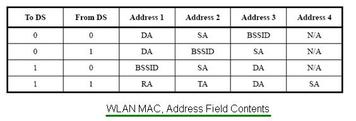WLAN 802.11ac Frame Format Explained
Advertisement
This page delves into the 802.11ac frame format used within the 11ac physical layer to construct 802.11ac compliant frames. The 802.11ac frame format, or structure, has been carefully designed to maintain compatibility with older standards such as 11a and 11n.
To achieve these compatibility goals, the 11ac frame format closely resembles the 11n mixed format. A key difference is that 11ac utilizes only one frame format, simplifying the physical layer implementation. The header within the 11ac frame has been modified to identify whether the transmission is intended for a single user or multiple users.
Let’s examine each field of the 11ac frame, as illustrated in the figure below:

As depicted, the 802.11ac frame comprises the following components: L-STF, L-LTF, L-SIG, VHT-SIG-A, VHT-STF, VHT-LTF, VHT-SIG-B, and the Data part. Here’s a breakdown of each:
L-STF and L-LTF
These fields are identical to those used in 11a. They span a total of 12 symbols and are used for frame identification and front-end synchronization.
L-SIG
This field is also the same as the one found in 802.11a. It specifies the data rate and the length of the frame in bytes.
VHT-SIG-A and VHT-SIG-B
These fields serve a similar purpose to the HT-SIG header field in 11n and the SIG field in 11a. In 11ac, the signal fields are divided into SIG-A and SIG-B. They provide information about the channel width, modulation-coding scheme, and whether the frame is intended for a single user or multiple users. These fields are utilized solely by 11ac devices and are ignored by 11a and 11n devices.
VHT-STF
This field performs the same function as the non-HT STF field. It helps the 11ac receiver detect the repeating pattern.
VHT-LTF
This field contains a sequence of symbols that aids in the demodulation of the remainder of the frame. Its length depends on the number of transmitted streams, and can be 1, 2, 4, 6, or 8 symbols. It is crucial for channel estimation and correction.
Data field
This field carries the actual data from the upper layers. If there is no data from the upper layers, the field is referred to as a Null Data Packet (NDP) and is primarily used for measurement and beamforming setup by the physical layer.
VHT Signal A field
This field is transmitted first in the 11ac frame. It utilizes BPSK1/2 modulation and coding. It contains rate information that allows the decoding of the 11ac physical layer frame payload.
VHT signal A fields = { Bandwidth (2 bits), STBC (1), Group ID (6), Number of space time streams (3), partial AID (9), Transmit power save forbidden (1), short GI (1), Short GI disambiguation (1), coding (1), LDPC extra symbol (1), MCS (4), beamformed (1), CRC (8), tail (8) }
VHT Signal B field
This field helps establish the data rate in 11ac and also assists in tuning MIMO. Like VHT Signal A, it is also BPSK1/2 coded.
VHT signal B fields={ Length (17, 19 or 21 bits), reserved (2 or 3 bits), tail bits (6) }
Advertisement
 RF
RF



